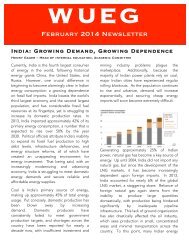You also want an ePaper? Increase the reach of your titles
YUMPU automatically turns print PDFs into web optimized ePapers that Google loves.
<strong>WUEG</strong><br />
<strong>March</strong> 2014 <strong>Newsletter</strong><br />
Solar Grid Storage LLC<br />
Connor Lippincott--Senior Member, Academic Committee<br />
For the second entry in the Sustainable<br />
Startups series, I decided to look at a recently<br />
acquired company working on solar energy<br />
storage, Solar Grid Storage LLC. But first, let’s<br />
take a look at who acquired them. SunEdison’s<br />
<strong>March</strong> 5th acquisition of the Philadelphiabased<br />
company made SunEdison “the first<br />
renewable energy company to offer solar, wind<br />
and energy storage.” They had previously<br />
acquired First Wind, a company which<br />
specialized in wind energy. By the end of the<br />
year, they hope to have 2,300 MW capacity of<br />
solar and wind energy projects. For<br />
comparison, Exelon reached 35,137 MW in<br />
total capacity and about 1,660 MW solar and<br />
wind capacity in 2013.<br />
The Solar Grid Storage acquisition is one of the<br />
first big moves in a growing solar energy<br />
storage field. However, using batteries to store<br />
solar energy is not a new concept. For most of<br />
the 1970s to the 90s, battery storage of solar<br />
energy was the norm. Once California began<br />
to incentivize solar energy being connected to<br />
the grid in 1996, the prevalence of batteries<br />
began to subside. Now, only 1 percent of solar<br />
installations include battery storage.<br />
Solar Grid Storage LLC looks to change that.<br />
Their technology works in tandem with the<br />
grid, allowing a PV system to have backup<br />
power during outages and to meet demand<br />
during peak energy times. Their projects range<br />
from 150 kW to 10 MW, meeting commercial<br />
demands rather than residential, which would<br />
only require up to 10 kW. Solar Grid Storage<br />
actually owns and operates the inverter and<br />
battery and makes money by providing<br />
services to the grid. Their technology also<br />
prevents the PV developers from having to pay<br />
for a solar inverter, as that cost is shared by<br />
both parties.<br />
Solar Grid Storage currently has four projects<br />
completed with five more in negotiations<br />
throughout the eastern coast. However, there<br />
is still much more potential for this technology.<br />
The number of PV systems in the country is<br />
skyrocketing, yet the number of PV systems<br />
with storage numbers only in the dozens. This<br />
number will continue to rise with the continued<br />
drop in lithium-ion battery technology and as<br />
more companies sign on. Elon Musk recently<br />
announced that Tesla was working on a solar<br />
storage option for individual residences.
However, there is some concern about the<br />
effect of solar-storage systems as the primary<br />
energy sources. These residences could in<br />
theory become completely independent of the<br />
grid. Although this may sound appealing to<br />
some, the overall effect on our energy system<br />
would be negative. Having a connected grid<br />
still is necessary. If the technology is used in<br />
tandem with the grid, it becomes a positive.<br />
This is why Solar Grid Storage is able to make<br />
money, as energy providers not only get their<br />
services but also allow them to keep customers<br />
on the grid.<br />
People seem excited about the solar and<br />
storage option, with Solar Grid Storage<br />
winning multiple awards in the months leading<br />
up to their acquisition. The technology will<br />
continue to improve, and will definitely be a<br />
part of the energy system going forward.<br />
Sources:<br />
SolarGrid Storage<br />
Clean Technica<br />
Greentech Media<br />
Cap-and-Trade in Europe: Getting It Right<br />
Charlie Gallagher – VP, Academic Committee<br />
The European Union Emissions Trading<br />
Scheme (EU ETS) is a cap-and-trade system,<br />
which 'caps' the total amount of carbon<br />
emitted and requires that firms exceeding<br />
individual limits purchase—or 'trade'—credits<br />
from other firms who have extra carbon<br />
emissions to sell. In other words, the European<br />
Commission sets a desired level of total carbon<br />
dioxide emissions for the year (and for each<br />
firm)—a level that will not be surpassed. If, for<br />
example, a coal power plant wants to emit one<br />
ton of CO 2 beyond the level designated for<br />
them, another firm must not emit (abate) one<br />
ton of CO 2, so the net effect is zero. The power<br />
plant can achieve this net zero effect by<br />
purchasing a credit on the EU ETS market, and<br />
the company that cuts their ton of CO 2 can<br />
make a profit by selling a credit in this market.<br />
Thus, firms that can cut their emissions more<br />
cheaply can sell credits to those firms that<br />
would rather buy a credit than incur the costs<br />
of abatement. Politically and economically, this<br />
is a popular alternative to a carbon tax, which is<br />
simply a $-per-ton price on any CO 2 emissions.<br />
Theoretically, the two policies achieve the<br />
same two results: there is less carbon in the<br />
atmosphere, and any product or service that<br />
emits carbon becomes more expensive.<br />
In theory, the price of the credit should reflect<br />
the ‘social cost’ of that ton of carbon in the<br />
atmosphere, such as acid rain lowering crop<br />
yield or the medical costs of treating a patient<br />
with lung disease in Beijing. However, the EU<br />
ETS has had less-than-optimal results so far, as<br />
over-allocation of free allowances—permits<br />
distributed by the government to allow firms to<br />
emit for free—has caused an over-supply and<br />
thus a low price for these credits.<br />
In an effort to amend the system and ensure a<br />
proper price of emissions credits, the<br />
European Parliament voted earlier this month<br />
to introduce a Market Stability Reserve. Under
this mechanism, the EU would remove free<br />
allowances from the market (lowering supply)<br />
when there are too many in the market and put<br />
them in a ‘reserve,’ or bank. When there are<br />
too few and the credits are trading at too high<br />
a price, the EU will take carbon credits from the<br />
reserve and inject them in the market<br />
(increasing supply), thus lowering the price.<br />
Through regulatory control of supply, the<br />
market should more accurately reflect the true<br />
cost of carbon emissions. This program plans<br />
to roll out in 2018, and with luck, a worldwide<br />
cap-and-trade system will follow in the years to<br />
come.<br />
Sources:<br />
The European Parliament<br />
Interfax Global Energy<br />
Oil Prices Will Rise by Year’s End<br />
Max Isenberg – senior member, Academic Committee<br />
The extended fall in oil prices has many<br />
clambering that this rop represents a paradigm<br />
shift in commodity pricing and that prices will<br />
remain low if not fall further through the end of<br />
the year. However, despite the lack of a<br />
rebound so far in <strong>2015</strong>, by the year’s end, oil<br />
could make up much of its loss since<br />
November, returning more than halfway to<br />
$100 oil from the WTI bottom around $40.<br />
The price of oil will be ultimately driven by<br />
changes in supply and demand, and the low<br />
prices will necessarily force an equilibration.<br />
Recent reports from American shale<br />
production sources have shown large declines<br />
in rig count (6% of total capacity coming off<br />
line in the span of a single week). While it’s true<br />
that the wells that are being shut off first are<br />
the most marginal and least profitable ones,<br />
the quick drop off in production from wells<br />
means that in the medium term, rig count<br />
drops will start squeezing supply as the<br />
remaining wells start to decline. Additionally,<br />
continued unrest in Iraq and the Middle East<br />
has left some supply unreliable and thus a drag<br />
on production.<br />
On the other side of the equilibrium equation<br />
is demand. With prices lower, one would<br />
expect consumption to increase, even of<br />
staples which have relatively inelastic demand.<br />
Indeed, a spike in demand did occur, as<br />
consumption increased by over 1 million<br />
barrels in February, reducing the size of the<br />
monthly surplus in production by two-thirds.<br />
While there is still an oversupply of oil, the rate<br />
by which this oversupply is growing is slowing<br />
and, by year’s end, can be expected to reverse,<br />
allowing prices to once again rise.<br />
Additionally, the US Federal Highway<br />
Administration released driving data for the<br />
month of December, the first full month after<br />
the price collapse, with a new record number<br />
of vehicle miles traveled. Finally on the<br />
demand side, sales of SUVs increased by 5% in<br />
February over the previous year. Though not<br />
the gas guzzlers of the past, light trucks still<br />
consume much more fuel than sedans and are<br />
becoming increasingly popular with the recent
drop in gas prices. With more trucks on the<br />
road, more gas will need will be inevitably<br />
demanded. Along with poor weather in the<br />
Eastern US and steady growth in Chinese and<br />
Middle Eastern demand, the price has<br />
significant upward pressures.<br />
Finally, much has been made of storage<br />
shortages in Cushing, Oklahoma. The thinking<br />
goes that should shortage run out, oil will be<br />
sold in a fire-sale as producers will do anything<br />
to get rid of their unstorable product. While<br />
the local storage around Cushing (desirable for<br />
its close proximity to the oil hub) may fill, oil<br />
remains a global commodity, and so the price<br />
will not be greatly affected as long as global<br />
storage remains available, which is the case.<br />
Also, there is nothing stopping storage from<br />
coming online in the next several months to<br />
help store even more inventory.<br />
While $100 WTI may not be around the corner<br />
for perhaps years to come, a meaningful<br />
rebound of oil prices to $70 this year seems in<br />
order. High cost production such as in<br />
American shale deposits will necessarily come<br />
offline as wildcatters find it increasingly<br />
uneconomical to produce. Demand has<br />
already surged and will continue to increase to<br />
help soak up the glut of oil, driving prices up.<br />
While storage may be scarce in the short term<br />
in particular locations, the potential for a fire<br />
sale remains distant.<br />
Sources:<br />
Yahoo! Finance<br />
OilPrice.com<br />
Wall Street Journal<br />
Bloomberg<br />
Oil Prices Will Remain At Current Levels<br />
Sheetal Akole – Senior member, Academic Committee<br />
After reaching a peak of over $105 per barrel in<br />
June 2014, WTI Crude Oil prices have been<br />
dropping rapidly, with the price currently less<br />
than half of its peak. Increasing oil supplies<br />
have contributed greatly to this drop in prices,<br />
especially as production in the United States<br />
has nearly doubled over the last six years.<br />
Looking forward, there is no indication of<br />
prices increasing by much in the short term, let<br />
alone reaching the highs of 2014. Instead, we<br />
will see an L-shaped recovery of oil prices,<br />
where they will continue to fluctuate between<br />
$40 and $55 per barrel in the short term.<br />
OPEC’s decision to not reduce production in<br />
November was the first indicator of these short<br />
term prices – by continuing current production,<br />
they continued to add to the global supply<br />
glut, driving prices further down. Despite<br />
OPEC’s refusal to cut back production, global<br />
production, and especially production in the<br />
United States, was expected to fall, as it was no<br />
longer as profitable to produce oil. While we<br />
have seen the number of oil rigs currently<br />
producing crude in the United States fall<br />
dramatically over the last few months, this<br />
reduction of oil rigs has only affected<br />
production capacity, leaving actual output<br />
relatively unchanged. In fact, the United States<br />
oil production has been steadily increasing<br />
recently. Supplies in the United States rose to
the highest levels on record, and the U.S.<br />
Energy Information Administration announced<br />
in its weekly report that U.S. crude oil<br />
inventories rose by 8.2 million barrels in the<br />
week ended <strong>March</strong> 20th, compared to an<br />
expected 5.2 million barrel increase. With no<br />
signs of a decrease in global oil production,<br />
fears of an increase in the glut have<br />
exacerbated, and oil prices remain low.<br />
However, the main factor that will continue to<br />
keep oil prices low over the next few years will<br />
be the dominance of shale oil, making up<br />
about half of total U.S. output, and 5% of<br />
global output. Shale has both low barriers to<br />
entry and barriers to exit, making shale<br />
producers extremely flexible and responsive to<br />
changes in crude oil prices. A shale well only<br />
takes several million dollars and a few weeks to<br />
extract oil and gas, compared to as long as 10<br />
years and billions of dollars for offshore wells.<br />
Thus, shale producers can quickly cut back<br />
costs (and production) in a downturn, and<br />
increase output at the slightest positive change<br />
in prices.<br />
Ongoing negotiations between Iran, the<br />
United States, and others could also have a<br />
significant impact on future oil prices. Relaxing<br />
the sanctions against Iran could further drive<br />
down global oil prices and increase the glut.<br />
Iran has almost 10% of the world’s proven<br />
reserves, but the sanctions have made it<br />
difficult for Iran to attract the foreign<br />
investment needed to extract the oil from the<br />
ground, and sanctions on Iranian shipping have<br />
also made it difficult for Iran to grow the<br />
industry. Despite this, The British tanker<br />
company Gibson’s estimates Iran has about 37<br />
million barrels of oil ready for immediate<br />
export. Lifting the sanctions would allow<br />
investment to flood into the country and oil to<br />
pour out of the country.<br />
Oil demand has also been growing slower than<br />
usual, with demand in developed countries<br />
such as the United States falling due to<br />
increased efficiency and weakening<br />
economies. China, who has been the main<br />
driver of the oil demand growth over the past<br />
few years, has also experienced weakening<br />
demand. India’s oil demand doesn’t seem to<br />
be strong enough in terms of absolute barrels<br />
to replace China’s demand, albeit strong<br />
growth in demand and encouraging policies.<br />
The combination of no visible decline in global<br />
oil supplies in the near future and tepid oil<br />
demand indicate there won’t be a strong<br />
recovery in oil prices for the next few years.<br />
Sources:<br />
Wall Street Journal<br />
Vox<br />
Statista<br />
Bloomberg<br />
The Binary Response of Shale to Oil Prices<br />
Arthur Chen – senior member, Academic Committee<br />
The precipitous decline in crude oil prices<br />
worldwide has sent ripples across the<br />
economic landscape, but the effects of $40 oil<br />
has been felt more strongly by no one other<br />
than oil and natural gas producers here in the<br />
US. However, the response has not been<br />
unified in one direction or another.<br />
Some oil and natural gas producers are putting<br />
the farm for sale, so to speak, and beginning to<br />
auction off some of their most valuable assets
in their pipelines and processing plants. With<br />
oil prices falling - and with no end in sight -<br />
producers have been forced to sell pipes and<br />
plants for some quick cash in order to stay in<br />
the black (on top of layoffs and spending cuts).<br />
One such deal involved Canadian gas giant<br />
Encana Corp., who solds its Bakken pipeline<br />
network for $3 billion to Kinder Morgan last<br />
month. Back in December, Encana also sold<br />
gas pipelines and plants in Western Canada’s<br />
Montney shale region for a sum of $328 million.<br />
Other companies that have done the same<br />
include Royal Dutch Shell and Devon Energy.<br />
Meanwhile, fellow producer Pioneer Natural<br />
Resources is seeking a similar deal for its Eagle<br />
Ford shale interests for an expected sale price<br />
of over $3 billion.<br />
Conversely, some shale producers are<br />
continuing to pump the black gold out of the<br />
ground, with the US shale oil industry as a<br />
whole pushing output to 30-year highs and<br />
contributing to stockpiles that are at their<br />
largest since tracking first began in 2004. It<br />
appears at first to go against business sense to<br />
do so with oil prices where they are, but<br />
studies suggest that doing otherwise would<br />
leave the producers severely in debt.<br />
Many in the industry have borrowed to risky<br />
levels of leverage, at more than three times<br />
operating profits. From a paper by derivatives<br />
expert Satyajit Das, if firms don’t meet existing<br />
debt commitments, then the resulting<br />
decrease in available funding and higher costs<br />
as debt markets close for these firms will create<br />
a negative spiral. Inability to borrow sharply<br />
reduces production capacity, and this lower<br />
production combined with low prices reduces<br />
cash flows to the point of possible default.<br />
Another study out of the Bank of International<br />
Settlements similarly revealed that American<br />
oil companies have developed quite the<br />
appetite for debt, with capital expenditures far<br />
exceeding cash flow. Thus, “highly leveraged<br />
producers may attempt to maintain, or even<br />
increase, output levels even as the oil prices<br />
falls in order to remain liquid and to meet<br />
interest payments and tighter credit<br />
conditions.”<br />
But the US isn’t the only country where shale<br />
producers are continuing to pump at a loss.<br />
Russia’s Rosneft and Brazil’s Petrobras are also<br />
overleveraged due to annual increases in<br />
borrowing by 13 percent in Russia, 25 percent<br />
in Brazil, and 31 percent in China. However,<br />
these companies have a distinct advantage in<br />
that they are all government-backed, so their<br />
financing needs are met by treasury or<br />
sovereign funds.<br />
Most forecasts for oil prices have crude staying<br />
fairly low for the near future, with futures<br />
markets as of writing putting WTI prices sub-<br />
$60 through December 2016. Therefore, one<br />
can expect both trends to continue as long as<br />
the market stays constrained. However, with<br />
the furious activity in the industry that has<br />
taken place, there may be a breaking point<br />
approaching where companies reach some<br />
sort of new normal where $50 oil is the<br />
benchmark, at least until oil’s next big move.<br />
Sources:<br />
Bloomberg<br />
Economonitor
CFL - an Amazing Investment<br />
Josh Haghani – Senior members, Academic Committee<br />
By replacing incandescent light bulbs with<br />
compact fluorescent lights (CFLs), a 476% taxfree<br />
annual return can be achieved. The EIA<br />
estimated that in 2012, 461 billion kWh were<br />
used to light both U.S. residential and<br />
commercial sectors. Lights amounted to 17%<br />
of total electricity consumption for the<br />
residential and commercial sectors, and an<br />
amazing 12% of total U.S. electricity<br />
consumption. A typical incandescent light bulb<br />
produces 1,600 lumens using 100 watts, while<br />
standard CFLs produces the same 1,600<br />
lumens using only 23 watts.[ii] By implementing<br />
CFLs instead of incandescent light bulbs, a<br />
77% energy saving can be achieved. An<br />
average household can save 13.09% of their<br />
electricity bill by switching to the more efficient<br />
CFLs. Total U.S. electricity consumption could<br />
be reduced by 9.24%, while giving consumers<br />
an annual tax-free return of 476%.<br />
Without taking into consideration the energy<br />
efficiency of CFLs, incandescent lights are still<br />
more expensive in the long run because<br />
incandescent light bulbs have a shorter<br />
expected lifetime. Richard A. Muller, in his<br />
book Energy For Future Presidents, explains<br />
“A tungsten bulb lasts typically 1,500 hours…<br />
that means that over the 10,000 hour lifetime of<br />
the CFL, you would have to buy more than six<br />
ordinary bulbs at a total cost over $2.”<br />
However, for my calculations I will give CFLs a<br />
handicap and only use the greater efficiency to<br />
calculate the annual return a consumer would<br />
achieve by switching to CFLs. I will compare a<br />
1,600 lumens, 26-watt Longstar brand CFL<br />
costing $3.89, to a 1,600 lumens, 100 watt GE<br />
brand incandescent light bulb costing $0.83.<br />
For my calculations I used 5 hours a day of<br />
typical light use, and $0.11 per kWh.<br />
Effective interest rate = (100%/payback period)<br />
= 476%<br />
Try earning a 476% return with any other<br />
investment!<br />
Sources:<br />
Energy Information Administration<br />
Home Depot<br />
Energy for Future Presidents<br />
Bulbs.com<br />
Amazon









